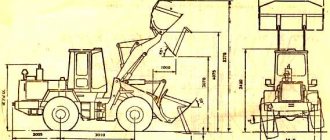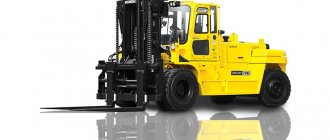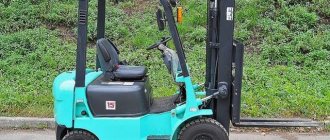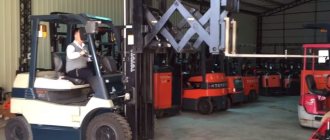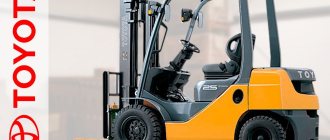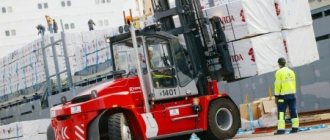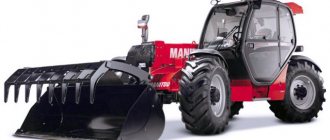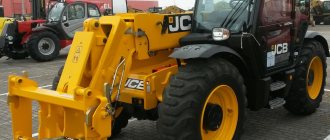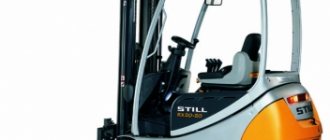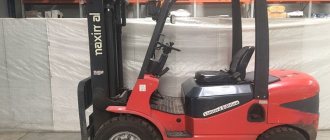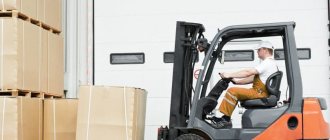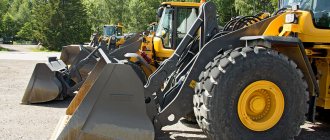To perform a variety of cargo operations - lifting and lowering, transportation, loading and unloading vehicles, warehousing and stacking - specialized self-propelled equipment on wheels is used. Forklifts are one of its most common and effective types.
This loading equipment is in demand not only for servicing warehouses, it is used everywhere where there is intensive processing of cargo flows, primarily with the use of pallets. In addition to warehouses and the surrounding area, fork loading units work effectively in production shops and in agriculture, at train stations and airports, and customs terminals. They demonstrate good maneuverability, load capacity and efficiency; they can be operated by just one person, this is the reason for their popularity
Optional equipment
Let us note several types of the most commonly used additional equipment that is installed on forklifts.
- Active stability system or SAS (System of Active Stability). Installed as additional rollover protection. If the permissible speed and turning radius parameters are exceeded, it blocks the steering and does not allow it to accelerate faster than the speed when the centrifugal force grows to critical values and becomes capable of overturning the car.
- Operator presence sensor. Also a security system. Installed in the driver's seat. Disables the ability to lift the forks and move the machine if the operator leaves the cab.
- Safety light. It illuminates the movement path several meters in front of the loader with a clearly visible, bright beam of light. Warns others when the forklift is moving around a corner or when leaving a building.
- Additional interior heater. Installed in forklifts with a closed cabin operating in northern regions.
- Non-standard lifting equipment. Typically, attachments for handling non-standard loads are ordered from the forklift manufacturer or supplier. Moreover, the range of various traverses, pincers, grippers and other types of equipment includes dozens of items and is only expanding every year.
Features of electric models
Electric forklifts, in turn, can be combined with battery-powered models. Both options are environmentally friendly, compact in size, quiet and maneuverable. For handling small shipments, this may be the best option. In other cases, the weak points of the equipment will appear - it is low-productive, and therefore is not suitable for regular maintenance of heavy cargo.
In addition, an electric forklift (we discussed the lifting capacity of different models above) is quite expensive in terms of money. Even compared to diesel fuel, electricity consumption for this type of equipment becomes a significant expense item. The same cannot be said about battery modifications, however. These are forklifts that are charged through a battery pack and can operate on accumulated energy for a limited time - from several hours to a day. But battery versions are inferior in terms of power even to their electric counterparts.
Summing up
Let's look at all the pros and cons of electric forklifts. Their advantages include:
- Economical - the electric motor has a minimum of rubbing parts, so such motors do not require regular maintenance. In addition, liquid fuels have a higher cost compared to electricity.
- Compactness – thanks to the small size of the electric motor, the entire structure of the loader has compact dimensions, which allows it to be used in confined spaces.
- No exhaust gases - thanks to this, electric forklifts can be used in closed warehouses, as well as when working with medicines and food.
- Quiet operation.
- Simplified operation and maintenance.
- Improved specifications and performance.
However, the main advantage may become the only, but quite important, disadvantage. The point is that the battery needs to be charged from time to time, and this takes time.
Of course, in a warehouse environment it is quite easy to find a power source, but it will still take much longer to fully charge the battery than to refuel an internal combustion engine. In addition, the battery has a limited life and will have to be replaced at certain intervals.
Description and principle of operation
In general, a forklift that receives energy from an internal combustion engine or battery consists of several main parts:
- frame and chassis on pneumatic or solid rubber wheels;
- power plant and transmission (in the case of an electric forklift - battery and electric motors);
- a hydraulic system, including one or more pumps and their actuators (hydraulic motors and hydraulic cylinders);
- lifting mast with carriage;
- steering and braking systems;
- auxiliary systems.
As a rule, forklifts and electric forklifts are used to transport piece goods on forks, usually mounted on pallets (pallets) or placed in special containers. The forks are mounted on the carriage. The carriage moves vertically along the mast. The mast usually has the ability to tilt. For ease of operation, the vast majority of these machines have a steerable rear axle. This makes it easier for the driver to manipulate the forks and easier to get into the intended cavities of the container when picking up a load.
Features of diesel models
This group also includes models with a traditional gasoline-powered internal combustion engine, but such equipment is gradually leaving the market. In fact, gasoline modifications have the same disadvantages and advantages, but if the user can come to terms with the disadvantages of operating a standard engine, then diesel fuel turns out to be more profitable.
If we talk about the disadvantages, then a diesel forklift is practically not suitable for use indoors, and sometimes in open areas. It is not only environmentally harmful, but also makes a lot of noise during operation. As for the advantages, the powerful diesel engine allows the equipment to cope with large volumes of cargo weighing about 20 tons, as well as control massive masts.
But this category is also diverse in its characteristics. Some low-power, low-emission versions, for example, can be used indoors as long as ventilation is active.
Types of technology
There are different types of forklifts available in the market. For example, they differ in the type of masts, the design of which determines the operating parameters of the forks. Thus, there are two-section and three-section mast designs in which the forks can be free-wheeling.
Another classification concerns the type of wheels. Pneumatic tubes with traditional tires are considered standard. They allow the equipment to develop sufficient speed, thanks to its shock-absorbing properties, also ensuring stability with minimal influence of vibrations. If you plan to use a forklift on a problematic surface with aggressive mechanical or chemical influence, then you should give preference to cast solid rubber. These are hard large wheels that have little depreciation, but in terms of wear resistance they are ahead of pneumatics. Modern models also feature polyurethane wheels, which perform well on flat warehouse floors.
The main classification concerns the type of power plant that drives the loader.
